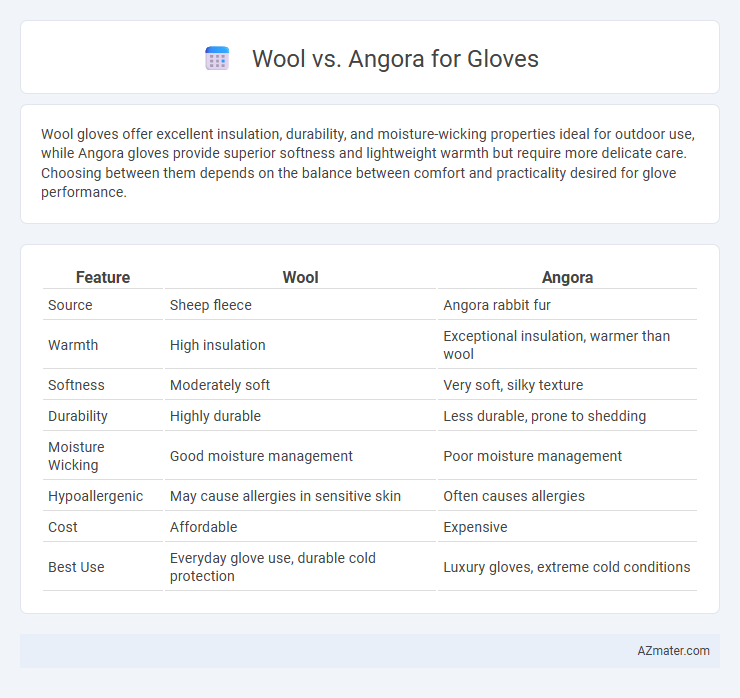Wool gloves offer excellent insulation, durability, and moisture-wicking properties ideal for outdoor use, while Angora gloves provide superior softness and lightweight warmth but require more delicate care. Choosing between them depends on the balance between comfort and practicality desired for glove performance.
Table of Comparison
| Feature | Wool | Angora |
|---|---|---|
| Source | Sheep fleece | Angora rabbit fur |
| Warmth | High insulation | Exceptional insulation, warmer than wool |
| Softness | Moderately soft | Very soft, silky texture |
| Durability | Highly durable | Less durable, prone to shedding |
| Moisture Wicking | Good moisture management | Poor moisture management |
| Hypoallergenic | May cause allergies in sensitive skin | Often causes allergies |
| Cost | Affordable | Expensive |
| Best Use | Everyday glove use, durable cold protection | Luxury gloves, extreme cold conditions |
Introduction: Comparing Wool and Angora for Gloves
Wool gloves offer superior durability and moisture-wicking properties, making them ideal for cold, wet conditions. Angora gloves provide exceptional softness and insulation due to the fine fibers from Angora rabbits, resulting in lightweight warmth. Selecting between wool and angora depends on the balance of durability versus softness and thermal performance needed for specific glove use.
Source and Composition of Wool and Angora
Wool for gloves is primarily sourced from sheep, consisting mostly of keratin protein fibers known for their elasticity, durability, and moisture-wicking properties. Angora wool comes from Angora rabbits and is composed of fine, hollow fibers that provide exceptional softness, warmth, and lightweight insulation. The unique fiber structure of Angora allows gloves to offer superior thermal regulation compared to traditional sheep wool gloves.
Texture and Softness Differences
Wool gloves offer a dense, slightly coarse texture that provides durable warmth, making them ideal for rugged outdoor use. Angora gloves, made from rabbit hair, deliver an exceptionally soft and silky feel, renowned for their luxurious smoothness and lightweight comfort. While wool emphasizes resilience and insulation, angora excels in softness and gentle touch against the skin.
Warmth and Insulation Properties
Wool possesses excellent warmth and insulation qualities due to its natural crimp, which traps heat and wicks moisture away from the skin, making it ideal for gloves in cold, damp conditions. Angora, derived from Angora rabbits, offers superior softness and exceptional insulation, providing warmth that can be up to three times greater than regular wool fibers. The high thermal retention of Angora fibers makes gloves exceptionally warm, though wool gloves tend to be more durable and moisture-resistant.
Durability and Wear Resistance
Wool gloves offer superior durability and wear resistance due to their tightly interlocked fibers, making them ideal for extended use in rugged conditions. Angora gloves, while exceptionally soft and warm, tend to be less durable because their fine, delicate fibers are prone to pilling and wear over time. Choosing wool gloves ensures longer-lasting protection and resilience, especially for activities involving frequent abrasion or heavy use.
Moisture-Wicking and Breathability
Wool gloves excel in moisture-wicking, effectively pulling sweat away from the skin to maintain dryness during extended wear, while also offering superior breathability due to their natural fiber structure. Angora gloves provide a softer texture but tend to retain more moisture, which can reduce breathability and may lead to discomfort in warmer or more active conditions. For optimal performance in moisture management and ventilation, wool is generally preferred in glove manufacturing.
Allergenic Potential and Skin Sensitivity
Wool, derived from sheep, often contains lanolin, which can trigger allergic reactions in sensitive individuals, causing itching and redness when worn as gloves. Angora, sourced from Angora rabbits, tends to be less allergenic due to lower lanolin content and a finer fiber structure, making it a better option for those with skin sensitivities. Both materials offer warmth, but angora gloves generally provide a softer feel with reduced risk of irritation compared to traditional wool gloves.
Ethical and Environmental Considerations
Wool gloves are often favored for their renewable and biodegradable properties, sourced from sheep with generally well-established farming practices supporting animal welfare certifications. Angora gloves, made from the fine fur of Angora rabbits, face ethical scrutiny due to invasive harvesting methods causing animal distress, prompting concerns from animal rights organizations. Environmentally, wool production typically has a lower carbon footprint and less habitat disruption compared to angora, which involves more intensive care and higher resource use for rabbits.
Care and Maintenance Requirements
Wool gloves require regular gentle washing with mild detergent and air drying to maintain softness and prevent shrinkage, while avoiding heat exposure is essential. Angora gloves need extra delicate care due to their fine fibers, including hand washing in cold water and flat drying to prevent matting or damage. Proper storage in a cool, dry place away from direct sunlight helps preserve the fiber quality and prolong the lifespan of both wool and angora gloves.
Cost Comparison and Value for Money
Wool gloves typically offer a more affordable price point compared to Angora gloves, making them a popular choice for budget-conscious shoppers. Angora gloves, while costing significantly more due to their luxurious softness and excellent insulation, provide superior warmth and durability. The added cost of Angora gloves often translates into better long-term value through enhanced comfort and extended wear resistance.

Infographic: Wool vs Angora for Glove
 azmater.com
azmater.com